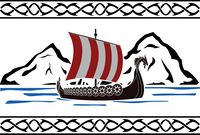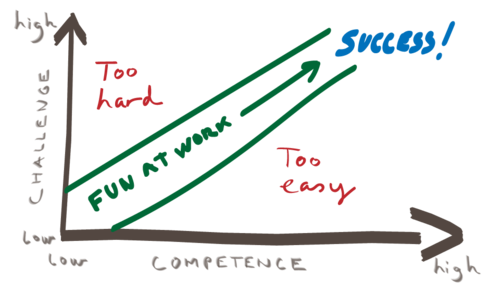Difference between revisions of "Baseline"
| Line 43: | Line 43: | ||
Please note that the zones are related to perceived challenge level, not actual competence. | Please note that the zones are related to perceived challenge level, not actual competence. | ||
| − | The zones are then related to personal development, also called [[ | + | The zones are then related to personal development, also called [[learning]]. |
| − | In the boring zone, we cannot learn, because we do things that are easy. The same is true for the comfort zone, although it is possible to get some training effect. In the [[flow|flow zone]], learning is most effective, and in addition it is most fun. As you see in the diagram, [[ | + | In the boring zone, we cannot learn, because we do things that are easy. The same is true for the comfort zone, although it is possible to get some training effect. In the [[flow|flow zone]], learning is most effective, and in addition it is most fun. As you see in the diagram, [[learning]] happens horizontally. We tackle a challenge that is somewhat above our current level of competence (going up in the diagram), and then we have more abilities later on (going to the right in the diagram). In total, this amounts to a diagonal movement towards success. |
In the panic zone challenges are too difficult. Most often we are unable to handle them. In some cases, we might be able to handle them, but still we cannot learn from them. It is like trying to learn to swim in an emergency situation. You are almost drowning: you might survive, but you do not learn swimming. | In the panic zone challenges are too difficult. Most often we are unable to handle them. In some cases, we might be able to handle them, but still we cannot learn from them. It is like trying to learn to swim in an emergency situation. You are almost drowning: you might survive, but you do not learn swimming. | ||
| − | Using [[ | + | Using [[learning]] in the [[flow|flow zone]], success is a continuous journey towards the upper right of the picture, based on the [[status quo|current level of competence and achievement]]. Each step prepares for the next bigger event to happen. |
Revision as of 15:10, 4 January 2017
Baseline from a Viking perspective means 'Be Prepared'
In the ancient Viking rules, we find §2 Be prepared with the sub-items
* Keep weapons in good condition * Keep in shape * Find good battle comrades * Agree on important points * Choose one chief
Attainable opportunities
It turns out that life is full of opportunities. We are not fit for all of them (yet). Some opportunities are too easy and not interesting for us. Others are too hard and therefore not applicable. Some of them are quite right and match our current level of competence. Taking them will prepare us for the next challenges. This way, our road to success is preparing us for more and more success, or for success at a higher level.
The following table illustrates the different zones that are relevant for personal development.
| Panic zone | Too hard. | We feel that these activities are too hard and we try to avoid them. |
|---|---|---|
| Flow zone | Difficult, but possible. | These activities are most rewarding. They are scary and exciting at the same time. |
| Comfort zone | Things we know. | These are the things we are most likely to do, we feel at ease. |
| Boring zone | Too easy. | We feel that these activities are too simple and we try to avoid them. |
Please note that the zones are related to perceived challenge level, not actual competence.
The zones are then related to personal development, also called learning. In the boring zone, we cannot learn, because we do things that are easy. The same is true for the comfort zone, although it is possible to get some training effect. In the flow zone, learning is most effective, and in addition it is most fun. As you see in the diagram, learning happens horizontally. We tackle a challenge that is somewhat above our current level of competence (going up in the diagram), and then we have more abilities later on (going to the right in the diagram). In total, this amounts to a diagonal movement towards success.
In the panic zone challenges are too difficult. Most often we are unable to handle them. In some cases, we might be able to handle them, but still we cannot learn from them. It is like trying to learn to swim in an emergency situation. You are almost drowning: you might survive, but you do not learn swimming.
Using learning in the flow zone, success is a continuous journey towards the upper right of the picture, based on the current level of competence and achievement. Each step prepares for the next bigger event to happen.

